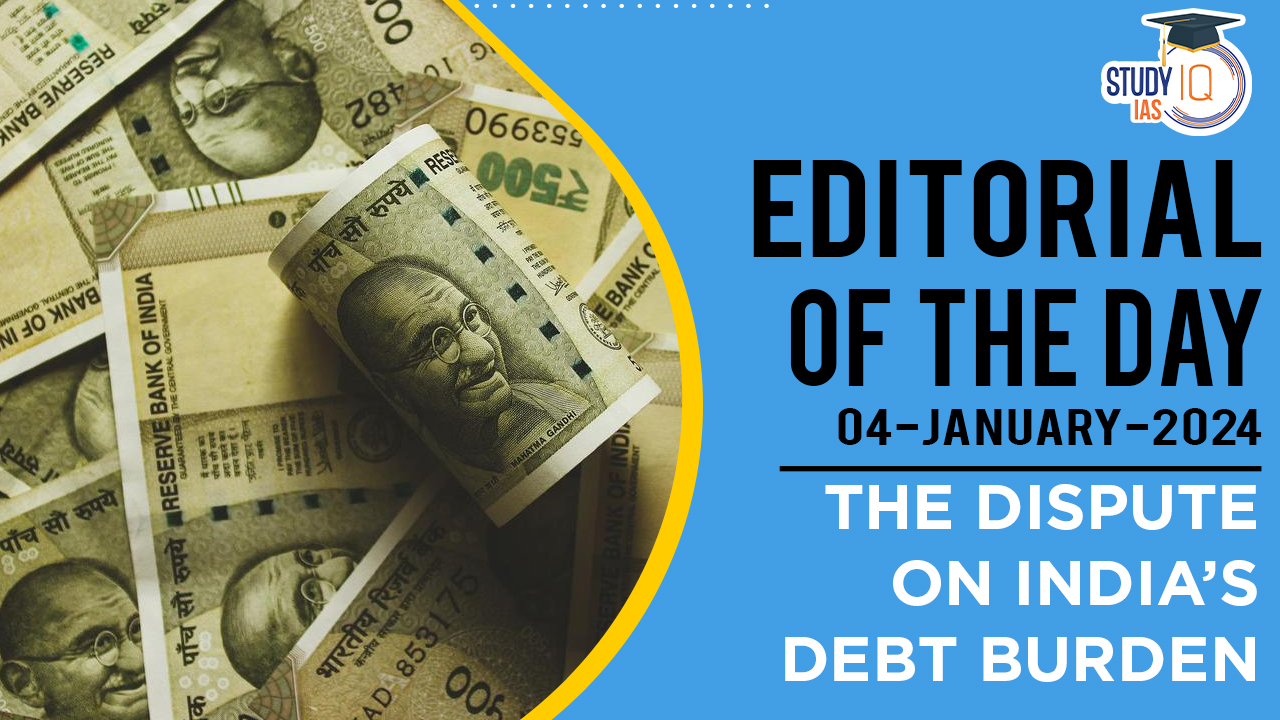Table of Contents
Context: India’s economic landscape has recently come under scrutiny following two noteworthy observations by the International Monetary Fund (IMF).
IMF Perspectives on India’s Economic Management and Debt Challenges
- Exchange Rate Classification: The IMF has reclassified India’s exchange rate from ‘floating’ to ‘stabilised arrangement’, indicating a managed currency potentially influenced by RBI interventions.
- Debt Sustainability: Concerns about India’s long-term debt sustainability, with projections of general government debt potentially reaching 100% of GDP by 2028. This projection is based on significant investments needed for climate change mitigation and resilience against natural disasters.
We’re now on WhatsApp. Click to Join
Broader Context of Worrying Global Debt Scenario
- Need for New Financing Methods: The IMF emphasises the necessity for new and, preferably, concessional financing sources. This is essential to fund climate change mitigation efforts, suggesting a significant role for private sector investment and carbon pricing mechanisms.
- Role of Government Borrowings: While government borrowings are pivotal in accelerating development, the burden of debt can hinder progress by limiting financing access, increasing borrowing costs, and causing currency devaluation and slow growth.
- UN’s Observation on Debt Servicing: The United Nations notes that countries are often forced to choose between servicing their debt and investing in crucial sectors like education and health.
- In 2022, 3.3 billion people lived in countries where more is spent on interest payments than on education or health.
- Global Public Debt Trends: Since 2000, global public debt has increased more than fourfold, whereas global GDP has only tripled.
- In 2022, global public debt hit a record USD 92 trillion, with developing countries accounting for nearly 30% of this, led by China, India, and Brazil.
- Higher Debt Growth in Developing Countries: Over the last decade, public debt in developing countries has risen faster than in developed countries.
- This increase is attributed to the need for development financing, the cost-of-living crisis, and climate change impacts.
- Asymmetric Burden of Debt: Developing countries face higher interest rates on debt than developed countries, affecting their debt sustainability.
- The number of countries where interest spending exceeds 10% of public revenues rose from 29 in 2010 to 55 in 2020.
- Contextualizing IMF’s Projections for India: The IMF’s concerning projections for India must be viewed within this global context, where developing nations are increasingly burdened by debt challenges.
Challenges for India’s Debt Burden
- Public Debt Management: As of March 2023, the Union government’s debt stood at ₹155.6 trillion, equivalent to 57.1% of GDP, while state governments’ debt was about 28% of GDP.
- These figures exceed the targets set by the Fiscal Responsibility and Budget Management Act (FRBMA) of 2005, which aimed for debt-to-GDP ratios of 40% for the Centre, 20% for States, and a combined 60%.
- Credit Ratings: Despite being the fastest-growing major economy, India’s sovereign investment ratings have not improved.
- Both Fitch Ratings and S&P Global Ratings have maintained India’s credit rating at ‘BBB- with a stable outlook’ since August 2006.
- This is the lowest investment-grade rating. Factors influencing this include the government’s fiscal performance, high debt levels, and India’s low per capita income.
- Fiscal Performance Issues: There are concerns about fiscal slippage in the fiscal year 2024.
- India Ratings and Research (IR&R) notes higher expenditures than budgeted on employment guarantee schemes and subsidies.
- For instance, the budgeted fertilizer subsidy of ₹44,000 crore was almost exhausted by October 2023, leading to an increase to ₹57,360 crore.
- Similarly, spending on the Mahatma Gandhi National Rural Employment Guarantee Act (MGNREGA) exceeded the budgeted amount, with additional funds being allocated.
- Challenges of an Election Year: The increase in subsidies and spending on employment schemes is not surprising in the context of the upcoming general elections.
- However, these fiscal decisions have implications for India’s economic stability and debt management.
- Sticking to a fiscal correction path in an election year is challenging but crucial to avoid worst-case scenarios.
- India Ratings and Research (IR&R) notes higher expenditures than budgeted on employment guarantee schemes and subsidies.
Way Forward
- Achieving Balance: The International Monetary Fund (IMF) highlights the need for India to strike a crucial balance, which involves maintaining a stable exchange rate and ensuring the sustainability of its long-term debt.
- Innovative Financing: Emphasises the importance of identifying new and preferably concessional financing sources. This approach is crucial for managing fiscal responsibilities more effectively.
- Boosting Private Sector Investment: Stresses the need for an increase in investments from the private sector, which is vital for fostering economic growth and stability.
- Implementing Carbon Pricing: Suggests the adoption of carbon pricing or similar mechanisms. This is aimed at addressing long-term environmental risks and promoting sustainable economic practices.
- Prudent Fiscal Management: Reflects a broader call for cautious and prudent fiscal policy management. This is particularly important in light of potential concerns regarding excessive management of exchange rates.


 Utkal Divas 2025: Odisha Foundation Day ...
Utkal Divas 2025: Odisha Foundation Day ...
 List of Military Exercises of India 2024...
List of Military Exercises of India 2024...
 GPS Spoofing and Its Impact in India: A ...
GPS Spoofing and Its Impact in India: A ...





















